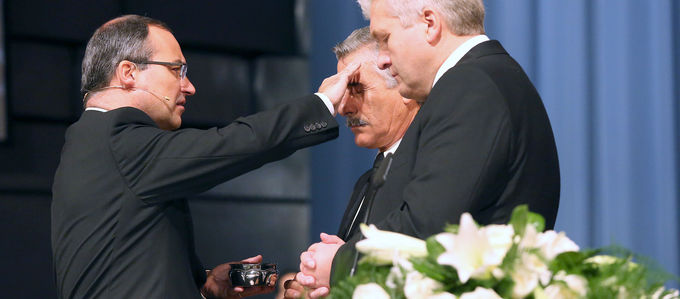
God wants to help all human beings, both the living and the dead. This conviction can already be found among the earliest Christians and is confirmed by the biblical motif of Christ’s descent into the realm of the dead—and corroborates the New Apostolic concept of the departed.
Christ’s descent into hell, Descensus, descent into the underworld: there are many names for it. What is meant is the notion that Jesus spent the period between His death and His resurrection in the world of the dead to preach salvation there.
Traces in the Bible
The biblical key witness is the first epistle of Peter, according to which Jesus “went and preached to the spirits in prison, who formerly were disobedient…in the days of Noah.” So “the gospel was preached also to those who are dead”. These are not the only traces, however, of the descensus in Holy Scripture.
According to Ephesians, Christ “descended into the lower parts of the earth”. The gospel of Matthew speaks of the “sign of the prophet of Jonah”, according to which the Son of Man was in the heart of the earth for three days and three nights (Matthew 12: 39–40). And John mentions the hour “when the dead will hear the voice of the Son of God”. These are just a few examples.
Older than Christianity
The Bible does not formulate a doctrine on the descent of Christ into hell. There are only a few isolated verses that stimulate in those addressed what they have known for a long time. For the idea of the descent of Christ into hell is older than Christianity. The notion already appears in Isaiah and Ezekiel and is further developed in early Jewish literature: there God remembers the dead who sleep in the graves, and descends to them “to bring them the glad tidings of His salvation”.
Early Christian literature continues the story with Jesus Christ as the protagonist. The Gospel of Peter, the Gospel of Nicodemus, the Odes of Solomon, or the Sibylline Oracles are apocryphal works from the second to the fourth century in which Christ not only descends into the realm of the dead to preach, but even to baptise and to liberate the dead from the underworld.
In theology and liturgy
At the same time, the Doctors of the Church examined the subject theologically: Ignatius of Antioch, Justin, or Irenaeus in the second century; Origen, Clemens, and Augustine from the fourth century on. The important thing for them was that Jesus really died and that He really conquered death. They were opposed to esoteric currents, which later were called Gnosticism.
The descent of Christ into hell became so important that it was incorporated into religious services. From 218 on at the latest, its commemoration constitutes the principal part of the Eucharistic prayer (anaphora). This is attested by the Traditio Apostolica (Apostolic Tradition), the mother of all church orders.
The descent of Christ into hell received the highest recognition in the fourth century in the synods of Nicaea and Constantinople, among others, and finally with its inclusion in the Apostles’ Creed. It is still one of the most important creeds of Christianity. It speaks of Jesus Christ as having “descended to the dead”.
The descent of Christ into hell really took off in the Roman West as well as in the Orthodox East of Christianity: the doctrine penetrated ecclesiastical poetry, music, preaching, and even further into the liturgy. Icon painting even developed its own genre of Christ’s descent into hell.
A Church feast in the East
To this day, the descent of Christ into hell is an important dogma of the Catholic Church. The Catechism of the Catholic Church deals with it in detail in articles 632 to 637. The Protestant Churches, on the other hand, have an issue with: “For many centuries, Christianity has managed without this statement of faith,” it says in one of their catechisms with a slightly critical view of the Apostles’ Creed.
The Orthodox Churches are very different. Here, Christ’s descent into the realm of the dead is one of the central doctrines. It is part of every Eucharistic prayer. And it even has its own Holy Day: the Saturday between Good Friday and Easter Sunday.
For the New Apostolic Church, the descent of Jesus is another point of origin for our concept of the departed—in addition to God’s universal will to save. “Thus the saving activity of Christ also encompasses the dead,” it says in our Catechism in section 3.4.10: “Ever since Jesus brought His sacrifice it has also been possible for the dead to attain redemption.”
Both Catholic and Protestant theologians see a close connection between the descensus verses of First Peter and a verse from First Corinthians. This is where vicarious baptism comes into the picture. What this is and what it means for the New Apostolic Church will be discussed in the next part.
Photo: christiane65 – stock.adobe.com














